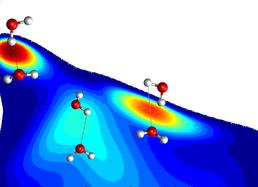Seminar 11th May 2012 4 p.m. 27:2001
Defining Hydrogen Bonds to Determine the Structure and Dynamics of Water
Dr Richard H. Henchman
Manchester Interdisciplinary Biocentre The University of Manchester
- Categories
- AMBER, Bioinformatics, Biomathematics, C, Density functional Theory, Developmental Biology, Emacs, Finite differences, Fortran, HECToR, HPC, Molecular Dynamics, Molecular Mechanics, Monte Carlo, Multi-physics, Multi-scale, Multigrid solvers, NWCHEM, ProtoMS, Quantum Chemistry, Quantum Dynamics
- Submitter
- Chris-Kriton Skylaris
Abstract
Despite over a century of research, there is still disagreement about the structure of water as well as its dynamics. Assuming a maximum of four hydrogen bonds and drawing on evidence of very few broken hydrogen bonds, water is commonly considered to be distorted tetrahedral and hydrogen-bond switching is highly concerted. Yet other data suggests that there is a variable number of hydrogen bonds including broken ones, which suggests a mixture of structures and that switching is stepwise. Much of the dispute hinges on how hydrogen bonds are defined. Most approaches require that a hydrogen bond has a minimum cut-off in strength. However, a single cut-off is either too restrictive or too generous.depending on the arrangement of molecules and fails to locate transition states for donors switching between acceptors. Here we present a simple, parameter-free definition of the hydrogen bond (J Phys Chem B, 2010, 114, 16792) that accurately identifies hydrogen bonds and transition states of hydrogen-bond switching. We present the resulting structure and dynamics of water and show how they resolve the conflicting data.
